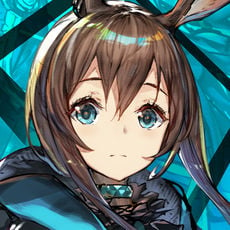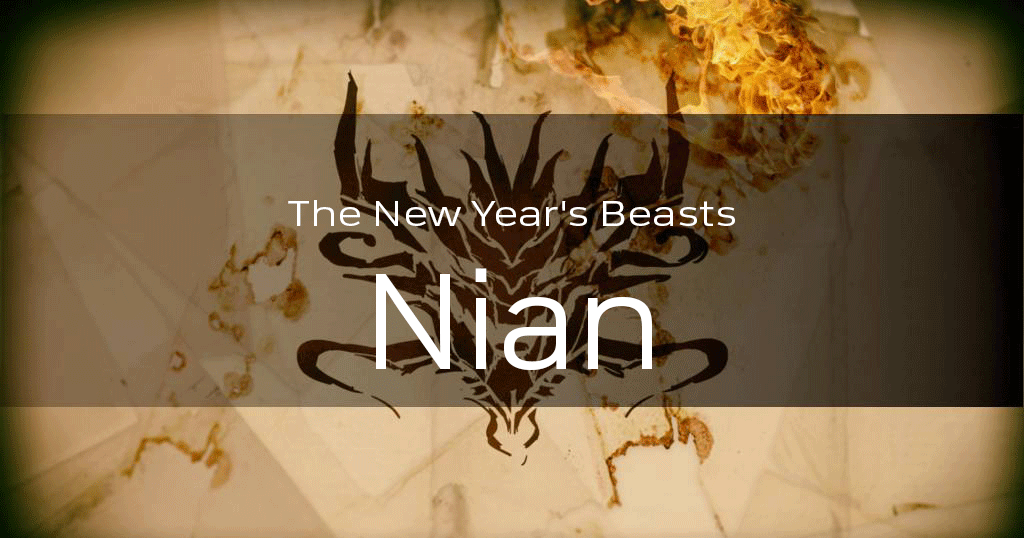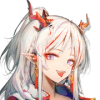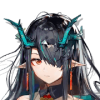Nian
If we are talking about Arknights’ most enigmatic characters, then the Nians siblings must be pretty up there on the list alongside the Abyssal Hunters and whatever Emperor and High Priest are. These mysterious 12 siblings only have 2 members known so far and yet every discussion about them can get even more heated than an August sun. So really, who, or what, are the Nians? Well, to answer that question, let's learn first about possible references that the Nians are based on, the eponymous Nian, and the False Dragons of Chinese mythology.
What is a Nian?
The legend of Nian describes a monster shaped like a dog with a lion's head and giant fangs, or a beast larger than an elephant with two long horns and countless sharp teeth. This monster would attack the village every Chinese New Year (beginning of spring), eating the crops and even the villagers.
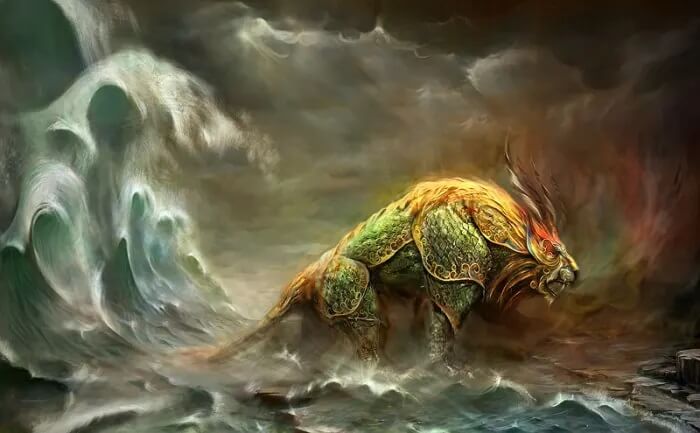
A modern rendition of what Nian might look like
It was after such an attack that the villagers discussed together on how to drive away the Nian. Some villagers mentioned that Nian was afraid of the color red, others mentioned how it was afraid of loud noises and fire. After this discussion, the villagers proceeded to prepare for their next confrontation next year. When the Nian came again at Chinese New Year, it was confronted by the villagers wearing bright red clothes, with red lanterns and red papers strapped everywhere. Along with the red objects, the villagers were also equipped with lots of musical instruments and fireworks.
The villagers produced the loudest sound possible with their musical instruments while the others threw fireworks at the Nian (monster abuse?). As a result, the monster ran away from the village in fear and terror. It was said that this practice then spread to other villages, making Nian unable to terrorise anyone anymore. The legend said it then became the mount of a Taoist monk/god.
It’s pretty obvious that the Nian siblings are based on this monster, with how the first of the siblings, Nian, literally has the same name and was released in CN during last year’s Chinese New Year. There were also the things she mentioned as being her ‘kind’s’ weakness during the Ancient Forge side event, but that’s a movie she made together with Lava so the authenticity is kinda doubtful there.
Further proof is how Dusk, Nian’s younger sister, was also released in CN for this year’s CNY. And after the new modified faction chart, how Nian and Dusk are assigned within the new Yan - Sui faction. The Sui (歳) hanzi means ‘age’, ‘period’, or ‘year’, basically synonymous with Nian (年) hanzi that also means ‘year’. With how Nian is included into Dusk’s limited banner and how limited operators are divided into anniversary banner (W and Rosmontis) and CNY banner (Nian and Dusk), it’s already beyond obvious that the Nians are modeled after the mythological Nian, in name and overall ‘behavior’ of appearing during CNY if not in ‘appearance’.
Extra fun fact, Dusk's hanzi, 夕 (Xi in Hanyu Pinyin, Hsi in Wade-Giles), also refers to another legendary 'yearly' beast who terrorised humans in certain regions in China. The beast is technically unnamed, but is also known as Chu Xi (除夕) which means "to eliminate dusk/night", or "to do away with dusk/night", from the name of the actual rituals used to drive it away. The meaning correlates to how the words are used commonly now, which is how one says Chinese New Year's Eve in Mandarin.
False Dragons
Alright, so if the Nians’ appearance (their E2 art) is not based on the original Nian, then what are they based on? Well, let’s take a look at their E2 arts again.
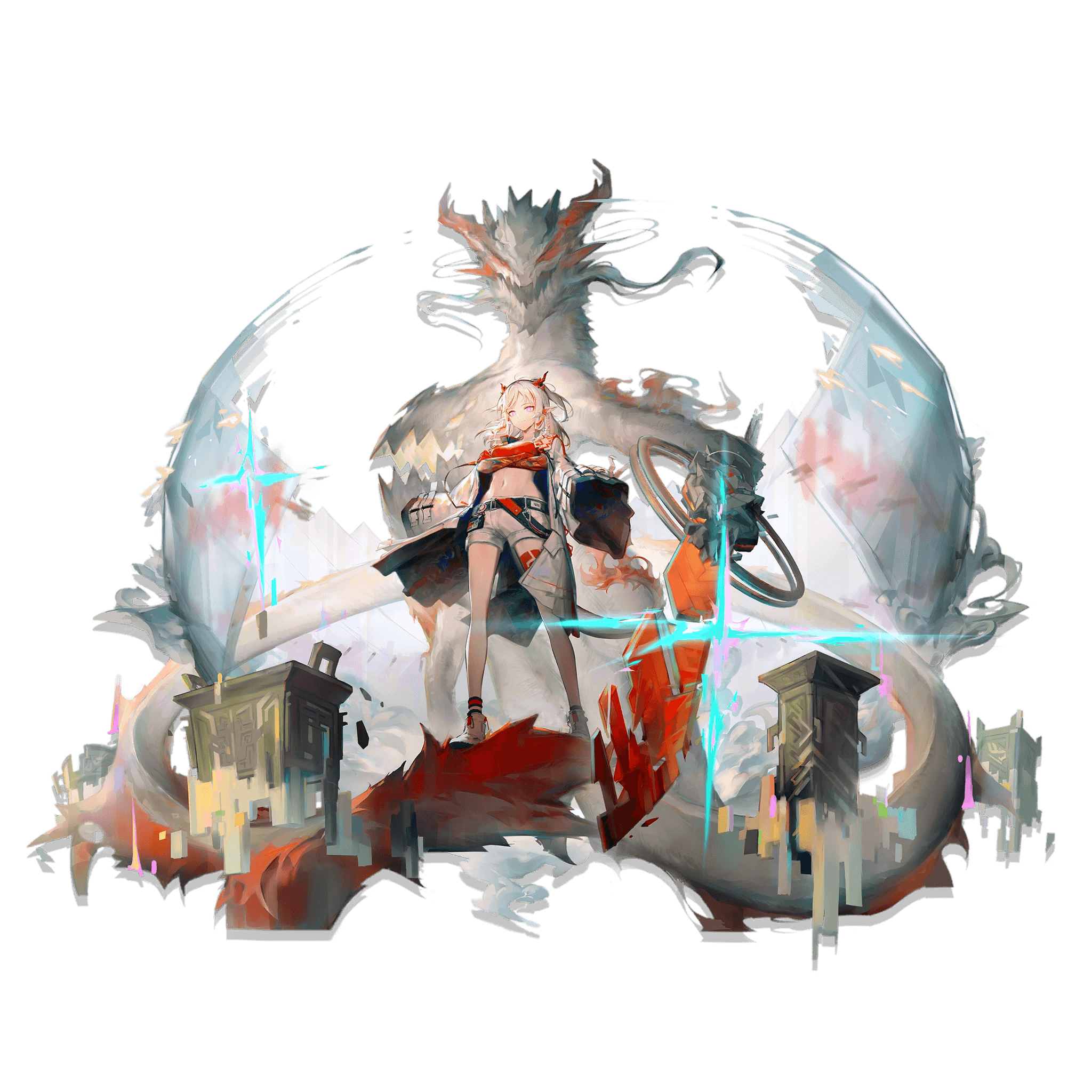
Nian E2 Art
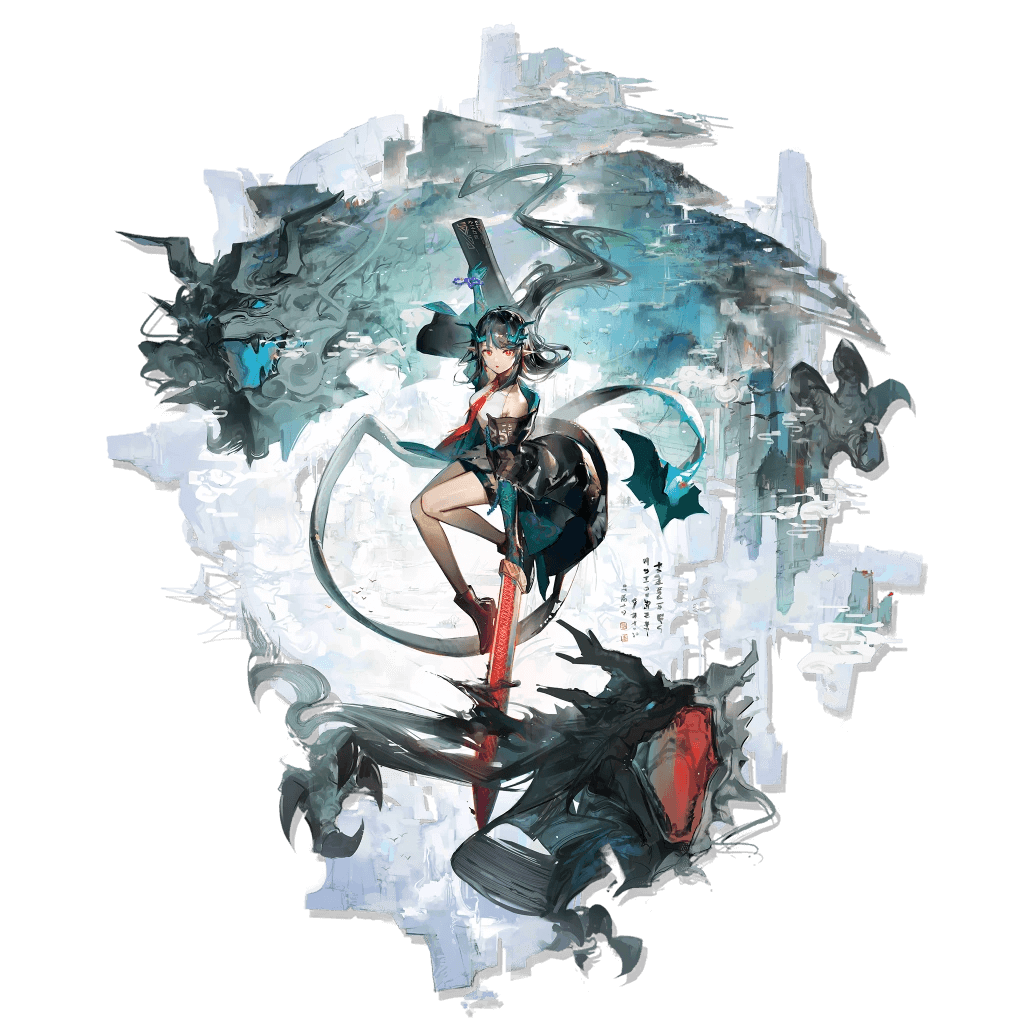
Dusk E2 Art
As you can see above, neither of the beasts in Nian and Dusk’s E2 art is remotely similar to the usual depiction of the mythological Nian. In fact, if you have to compare it to something, they look closer to the classic eastern dragon, though of course they’re nowhere like Ch’en’s E2 art.
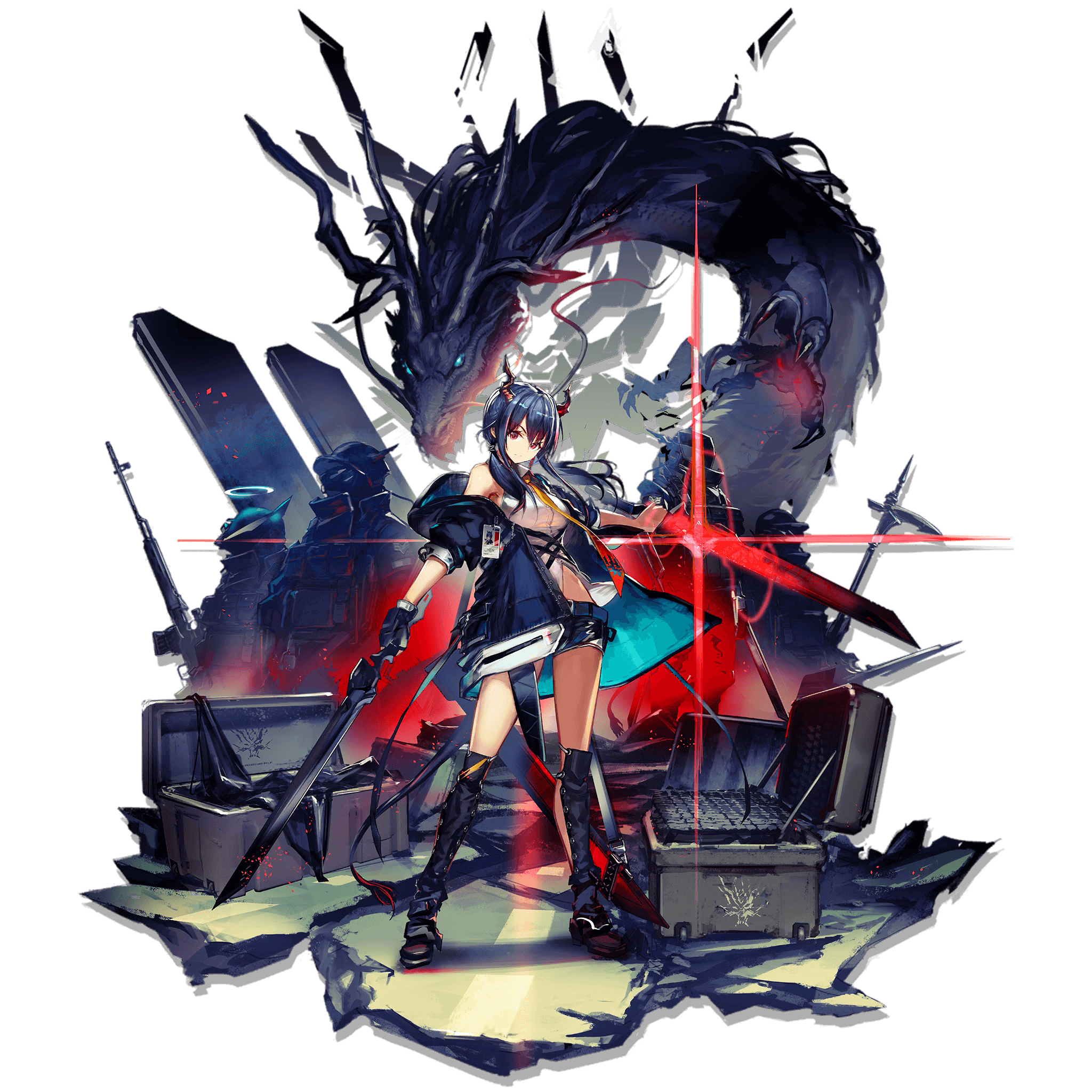
Ch'en E2 Art
Yeah, pretty different on the head part. The body of the Nians are thicker as well. Alright, so it’s like a dragon, but not an actual dragon, so what is it? Well, let me point you towards the creatures called False Dragons, or commonly known as Sons of the Dragon, in Chinese myth.
These so-called sons are the children of the Dragon King (龍王), and although their father is definitely a dragon, these children are more like a hybrid of a dragon and other creatures rather than a true dragon. In many works, commonly there are only 9 sons of the dragons, instead of outright 12. The work Wuzazu, written at the end of 16th century, list them as such, from oldest to youngest:
- The Qiú Niú 囚牛 (Prisoner Cow), (hybrid between a cow and a dragon) a creature that likes music, used to adorn musical instruments.
- The Yá Zì 睚眦 (Small Grievance), (hybrid of wolf and dragon) a creature that likes to fight, is aggressive and is normally found on cross-guards on sword as ornaments.
- The Cháo Fēng 嘲風 (Jeering Wind), (hybrid of a phoenix and dragon) a creature that likes to adventure. They are typically placed on the four corners of roofs.
- The Pú Láo 蒲牢 (Firm Calamus), (four legged small shore-dwelling dragon) a creature that likes to scream, and is represented on the tops of bells, used as handles.
- The Suān Ní 狻猊 (Lion), (hybrid of lion and dragon) a creature that likes to sit down, is represented upon the bases of Buddhist idols (under the Buddhas' or Bodhisattvas' feet).
- The Bì Xì 贔屭 (Supporting Strength), also known as Bà Xià 霸下 (Lower Tyrant), (hybrid of turtle and dragon) a creature with a large shell able to carry heavy objects, and is normally found on under grave-monuments.
- The Bì Àn 狴犴 (Prison), (hybrid of tiger and dragon) a creature that likes litigation, and is placed over prison gates (in order to keep guard).
- The Gōng Fù 蚣蝮 (Centipede Viper), (hybrid of reptile and dragon) a creature that likes to drink water, and is typically used on bridge structures. (Originally read as Bā Xià but the original hanzi are too strong for Unicode)
- The Chī Wěn 螭吻 (Hornless Mouth), (hybrid of fish and dragon) a creature that likes swallowing, are placed on both ends of the ridgepoles of roofs (to swallow all evil influences).
Outside of the 9 mentioned above, there are other versions that mention different sons, for example:
- The Tāo Tiè 饕餮 (Glutton), (form of beast) a creature which loves to eat and is found on food-related wares.
- The Jiāo Tú 椒圖 (Pepper Diagram), (looks like a conch or clam) it does not like to be disturbed, and is used on the front door or the doorstep.
- The Fù Xì 負屭 (Repudiating Strength), (a kind of a small dragon) it is fond of literature, and can be found on the top of tombstones.
With both lists combined, we will have 12 creatures, equal with 12 Nian siblings. With this list we can even go one step further and see if any of the known siblings so far actually match with one of them. I’m not really sure yet with Dusk, but it seems possible that Nian’s skills in blacksmithing is a reference to Yazi, with how the creature is used to adorn swords.
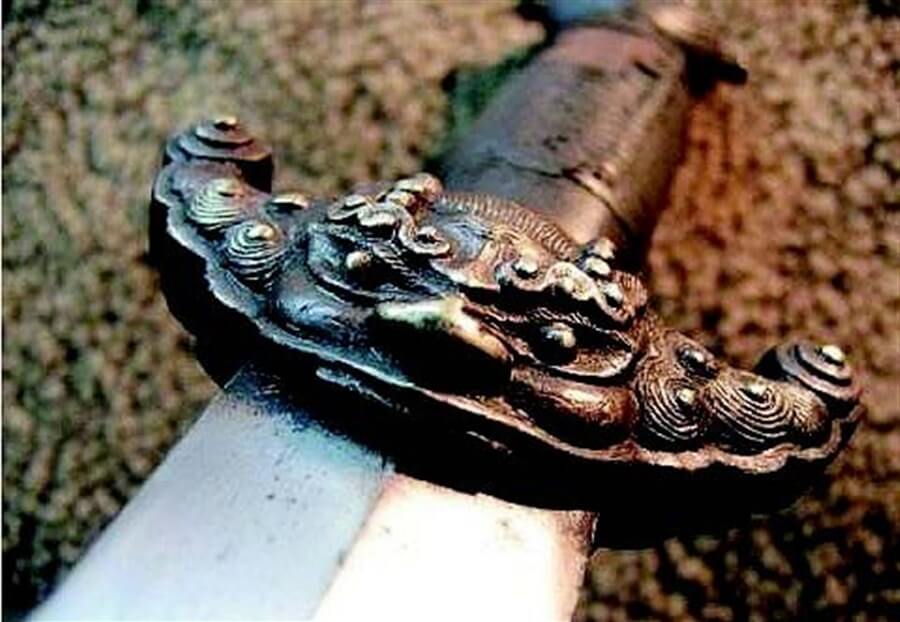
A Yazi decoration on a sword’s crossguard
As we can see, the shape of Yazi’s head is pretty similar to the beast’s head in Nian’s E2 art, further supporting the theory.
Another supporting theory is the poem in Nian’s E2 Promotion Record:
"There exist beasts of chalk | Their bellies a great furnace
In nine they come | Their horns like hot copper
Time passes and colors fade | The year turns once more
…
Harken | The forge of the sky | Awaits five earthborn metals
Among the ten peoples | Walk beasts tenfold
…
With a single stroke | Ruination befalls a hundred worlds
Countries turn to rust | A brief spark in the wind | A bubble gone without a trace"Many parts are blurred and cannot be read
For the sake of accuracy, let's take a look at the CN script as well.
"有兽如垩 腹若大釜
其数为九 角似赤铜
时久色迁 几近日气
...
语曰 天有洪炉 地生五金
人有十类 兽亦百种
...
伐谋百世 一朝毁之
国蚀器锈 如梦似电 无踪泡影”许多部分已经模糊,没法阅读了。
From the script above, a better translation might be something like this:
Twas a chalk-like beast | Its belly like a great cauldron
Its number is nine | Its horn akin to red copper
Time passes, color changes | It became white as day
…
As is spoken | A great forge exists in Heavens | Five metals are born from Earth
There are ten types of beings | There are hundreds of beasts
…
A hundred lifetimes it schemed | An entire dynasty it ruined
Country corroded, weapons rusted | Like a dream, like a lighting | Not a shadow left behindMany parts are obscured and cannot be read.
The first passage of the poem clearly refers to Nian. Her E2 art depicts a beast with a body the color of chalk and horns the color of red copper. If you have seen forging videos, you would see blacksmith adding powder-like substance on the metal. This powder is Borax, used to prevent oxidation of the metal surface and so keeping the surface clean from impurities. Many people often confuse the material to a normal chalk. The number nine, meanwhile, points to her order among her siblings.
The second passage’s first line makes it even more obvious that it refers to smithing. Forge of Heavens is obvious enough, while the five metals born from earth, or five earthborn metals according to the book Tiangong Kaiwu, are gold, silver, copper, iron, and tin. The last three of which are mentioned by name in Nian’s skills.
The second line meanwhile refers to Chinese-Buddhist cosmology, “ten types of beings” referring to 10 realms that all beings are usually classified into. The realms are further divided into 6 Mortal Realms and 4 Higher Realms. The 6 Mortal Realms are Hell, Hungry Ghosts or Pretas, Demons or Asuras, Beasts, Humans, and Gods. Meanwhile the 4 Higher Realms are Sravaka, Pratyekabuddha, Bodhisattva, and finally completely enlightened Buddhahood. If you have ever read Journey to the West, then you will realise that the “hundreds of beasts” might refer to the countless animals or beasts who attained spiritual power and became demons, or those who are originally born as demons already, or maybe beings who are not counted among the ten type of beings, like Sun Wukong. It’s kinda ambiguous, but this line might mean Nian and her kind are considered as part of these “beasts” as the hanzi used, Shou (兽), to refer to "beast" is the same one used to denote the Nian in Mandarin (年兽 Nian Shou, literally Yearly Beast).
The last passage meanwhile is spoiler area, and will be discussed in the last section as it heavily intrudes into Who is Real infodump.
While we are at it, let's try analyzing Dusk's E2 Promotion Record as well.
“有兽色青 形似重峦
其数十一 戴月披烟
云涛微茫 暮沉色见
须靛似林 骨峭如石
语曰 星藏点雪 月隐晦明
人有清浊 色有佳劣
五兵难伤 五火难防
焚其血肉 墨泉流涌 雾穷烟尽 两首无羁
然其兽难制 晨昏方易 顿尔消弭
其形亦伪 其物亦伪
笔缀卷阖 如醉似痴 一夕烬尽”拓本是完整的,但内容令人感到不安。
The translations are roughly like this:
"Twas a beast the color of azure | Its shape a heavy mountain
Its number is eleven | Shrouded by moonlight and fog
Clouds and waves, miniscule yet vast | Glimpsing through a falling twilight
Its indigo whiskers akin to forest | Its bones akin to rocks
As is spoken | Concealing stars, a speck of snow | Hiding moon, obscuring daybreak
People can be turbid and clear | Colors can be vibrant and dull
Five armies unable to hurt | Five flames unable to defend
Burn its flesh and blood | Spring of ink gushing forth | Dispelling mist and fog | Twin heads detained naught
Still the beast is unshackled | As dusk became dawn | It suddenly vanished
Its form is false | Its being is false
The brush stops, closing everything | Like a drunk, like a fool | The night is over"The rubbing is complete, but the content is disturbing.
Compared to Nian's poem, Dusk's is complete and definitely more artistic in nature. Just like Nian, the first lines, first to fourth, described Dusk's appearance, and how her order is eleventh among her siblings. Her color is written as azure, although her E2 art shows a green-colored beast, this is because both green and blue are considered the same color back in ancient China under the same hanzi Qing (青).
The fifth to ninth line refers to Dusk's ability. Her ability is essentially to create 'real illusions' from her paintings and therefore one can't really attack it or defend from it. Neither can one even try to shackle it down. In the end the night will end and the beast will disappear, just like the Chu Xi I mentioned before. The "Twin heads detained naught" probably also refer how there are two beasts in Dusk's E2 art, hence "twin heads".
The last two lines, meanwhile, just like Nian's, refer to the true nature of Nian and her siblings, and basically spoiler area. "Like a drunk, like a fool" basically means even the drunk's intoxicated time will be over, so does the fool's daydream. That nothing lasts forever.
Besides Nian and Dusk, we also know about a sibling that loves to cook, possibly referencing Taotie, and another one that loves calligraphy, which I’m not so sure referencing which False Dragon. As for the other siblings, we will have to wait until the next Chinese New Year to know.
The Siblings’ Past and Future
Alright, now, spoiler area. Don’t say I didn’t warn you.
A long long long ass time ago, there was a being called the First Dragon, who is also the First Emperor of Yen. He asked his ministers, why wouldn’t the gods protect Yen and help their people? He then set off on a journey to find one of these gods. When he found one, the being said that the gods (well, the other gods) would reject his proposal because they don’t care about mortals.
But the First Dragon cares about his people too much, so he waged war against the gods. The first god he met betrayed their kin and helped him. He then killed all the gods who opposed him and banished the rest who were against Yen. Finally, when the First Dragon has grown old, he met the first god who helped him and made them bow to Yen.
The gods then hid and sown their seeds, making their fragmented souls to act in their place. These fragments are what Nian, Dusk, and probably their siblings are. When their true forms (the gods) awaken, they will all disappear, or more accurately, get erased.
Now this is where things get kinda unclear because Chinese can often become really ambiguous without complete context. Nian basically said that her siblings all have different motivations, she said some are like Dusk, idly wasting their time with their hobby, while others stand with Yen (whether this means helping Yen or opposing it, I am unclear). Another unclear context I am having is whether Nian and her siblings are fragments from different gods, or if they are all fragments from a single god. At the moment I am leaning to the latter, because else their individualities would be hella weird to explain if they come from the same god.
Anyway, that’s what Who is Real event told us about in relation to Nian and her siblings' past, as well as what Nian is trying to do. She is trying to unite her siblings to fight against their fate, to basically ensure their own existences as their own current self. Not to undersell her motivation, but it’s a fairly standard motivation for JRPG protagonists with identity crisis, so I am pretty sure most of us can quite foresee how Nian might have way harder time with her probably more hardcore siblings compared to Dusk. And after the siblings unite, who can say for sure what they will do? Maybe they will help Wei in his coup, lol
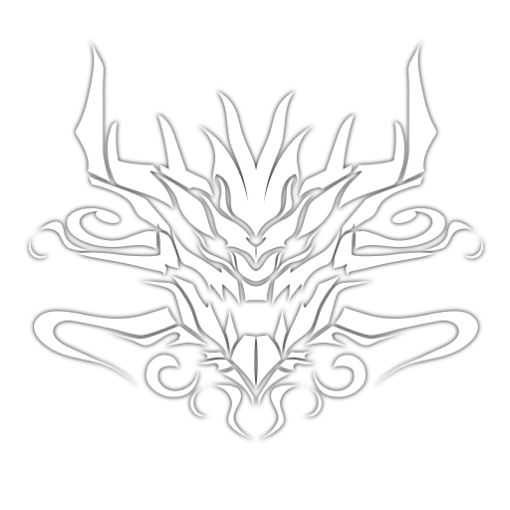
Many thanks to RIHQ lore room as well as my other discord servers who helped me with the creation of this article, especially Laulicon for that summary on Nian and Dusk’s past. Once again, all of what I wrote here is my own interpretation on Nian and her siblings, and might not be shared by others. I have also tried to simplify cultural references so as to make it easier for those who are not fluent in the topic, and therefore apologies for anyone who might feel offended. (For this reason I also didn’t try to find any reference for what the First Dragon did, because I couldn’t really find a match in Chinese myth and other mythologies might be too vast for this.)

